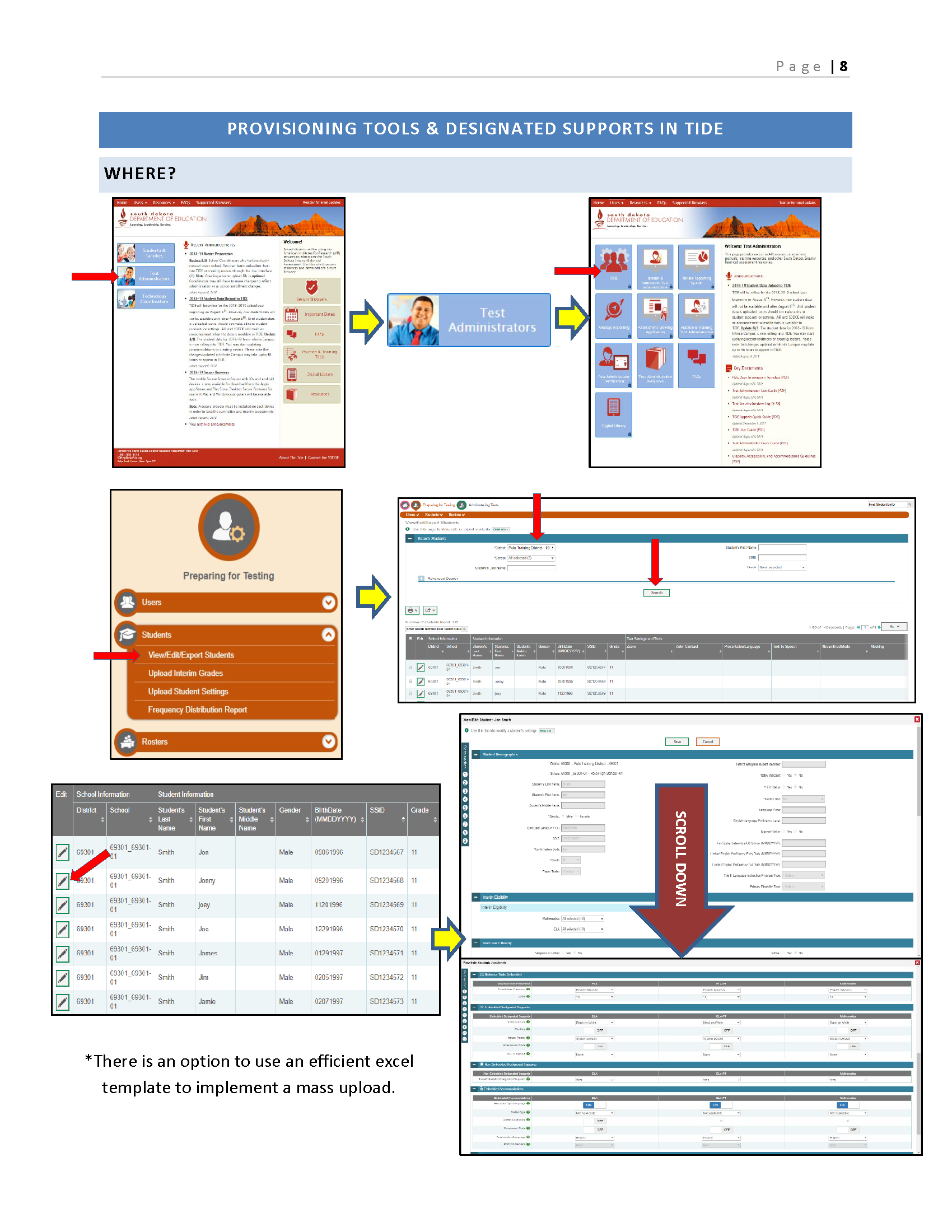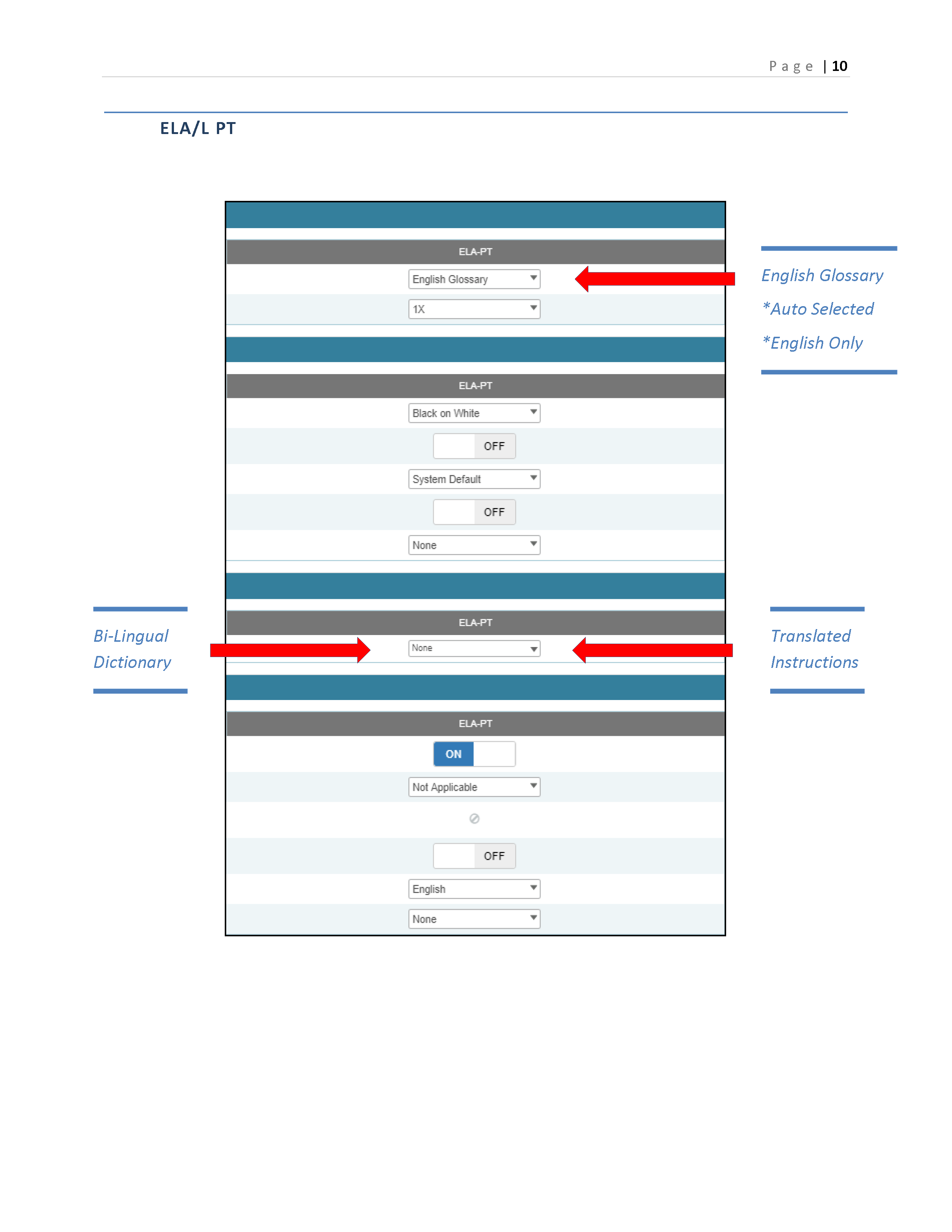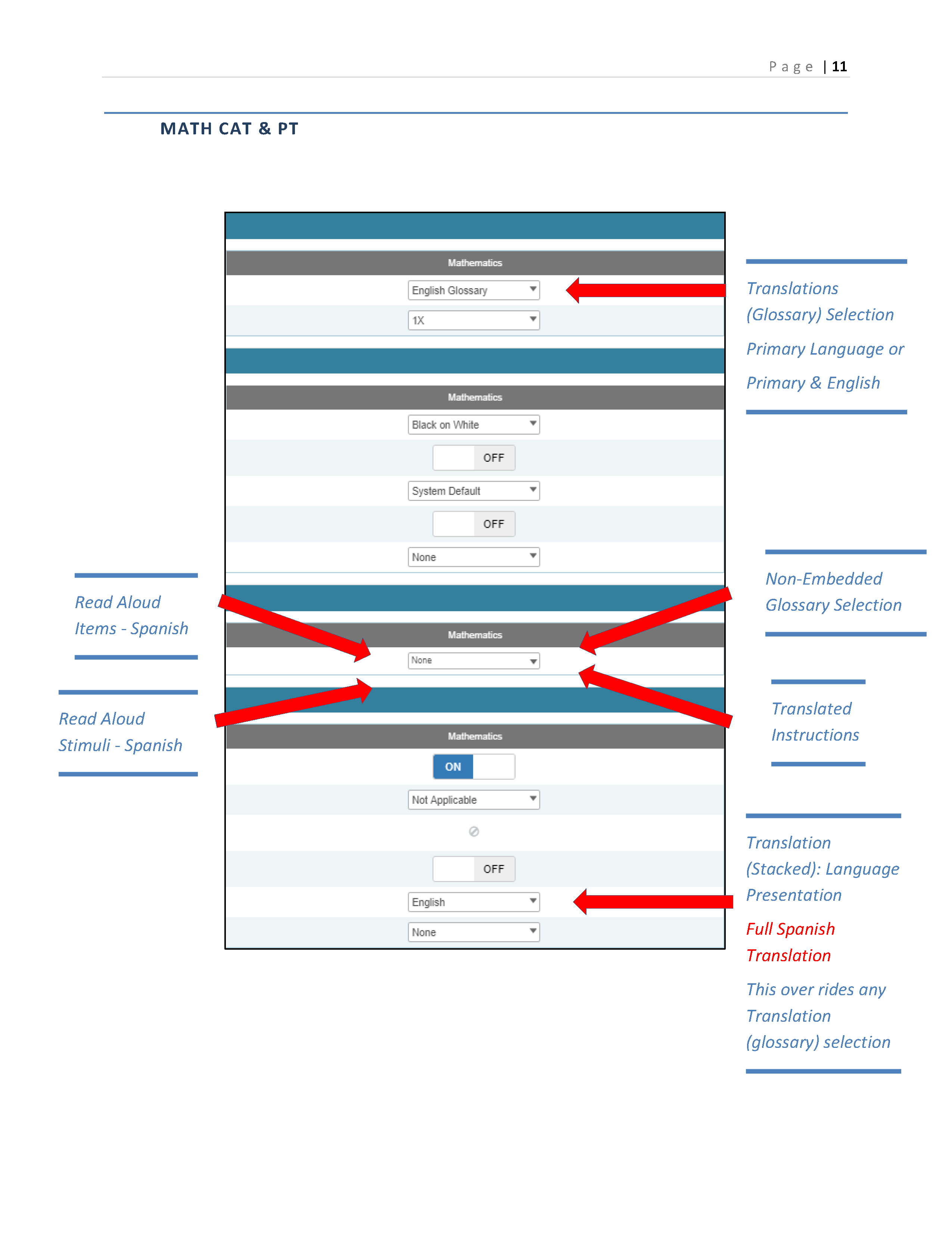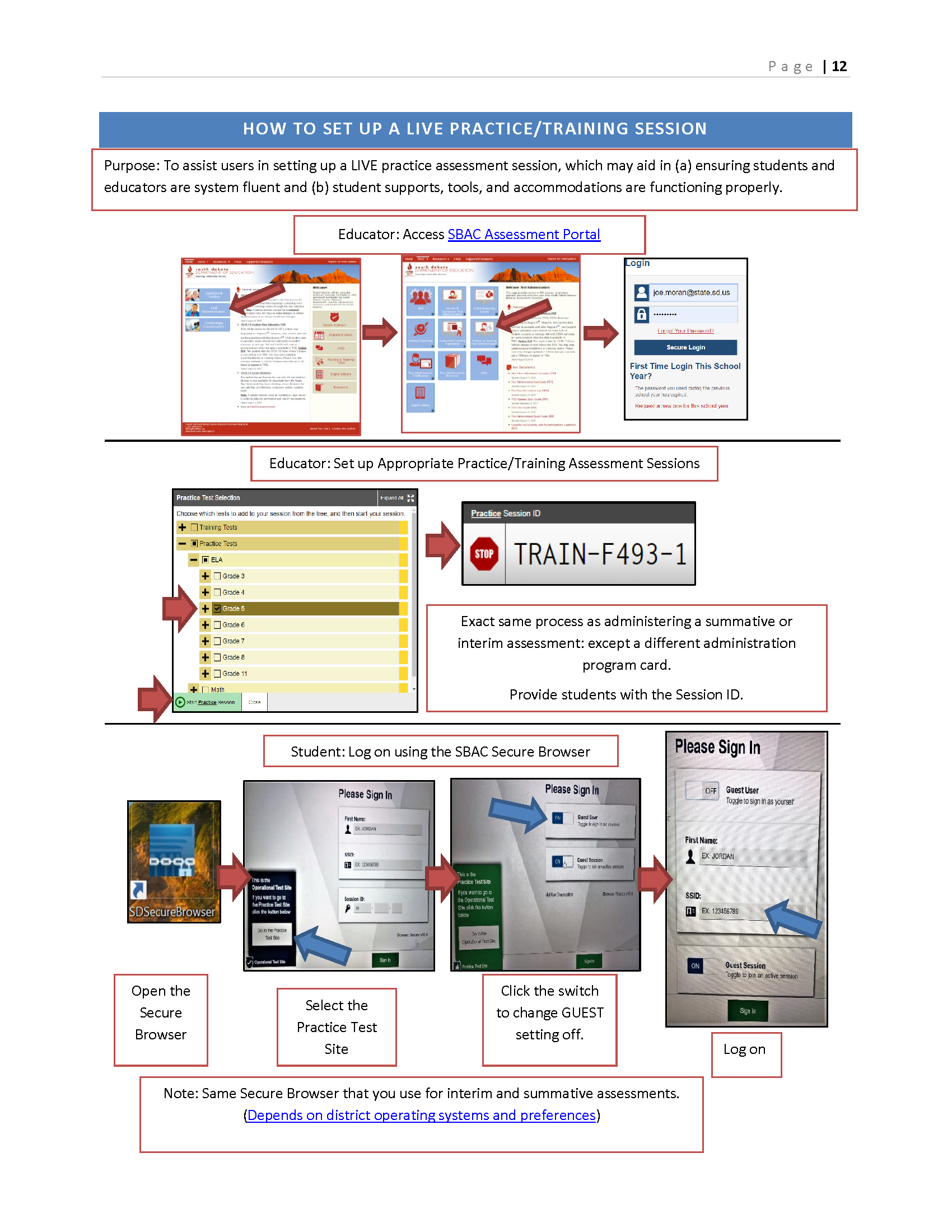Smarter Balanced UAAG Supplement – Language Supports Yutzil Becker
State EL/Title III Coordinator Yutzil.Becker@state.sd.us
605.773.4698
Terminology & notation
English Learners
- EL – Federal education classification for students who are learning English as a secondary language.
- First Year in Country: An EL student who has not had a school enrollment within the United States, for more than 12 months—excluding any school enrollment from Puerto Rico.
- Student must be identified as EL
- Student entered the United States between May 2nd—of previous school year—and May 1st—of the current school year
- Identification provides a one-time exemption from the current year’s ELA/L summative assessment administration
- Students must still take Math and Science, if necessary based on grade level
Smarter Balanced Accessibility
- Universal Tools: Accessibility resources of the assessment that are available to ALL students, based on student preferences and selection.
- Designated Supports: Accessibility resources of the assessment that are available to ANY student, based on decisions made by an educational team.
- Accommodations: Changes in procedures or materials that increase equitable access during assessments—but do not change the content or rigor being assessed—based on documentation of an IEP or 504 plans.
Smarter Balanced Assessment
- Embedded: Assessment resources provided within the computerized assessment platform
- Non-Embedded: Assessment resources provided outside the computerized assessment platform
- ELA/L: English Language Arts & Literacy
- CAT: Computer Adaptive Assessment – Each student experiences a different set of assessment items based on their performance.
- PT: Performance Task – Connected assessment items that are all related to a singular task aimed at measuring the higher cognitive capabilities and depth of knowledge.
Smarter Balanced Language Supports
Embedded Universal Tools
|
Universal Tool |
Description |
| English Dictionary
(for ELA-performance task full writes) |
An English dictionary may be available for the full write portion of an ELA performance task. A full write is the second part of a performance task. The use of this universal tool may result in the student needing additional overall time to complete the assessment. |
| English Glossary | Grade- and context-appropriate definitions of specific construct-irrelevant terms are shown in English on the screen via a pop-up window. The student can access the embedded glossary by clicking on any of the pre-selected terms. The use of this accommodation may result in the student needing additional overall time to complete the assessment. |
| Thesaurus
(for ELA performance task full writes) |
A thesaurus is available for the full write portion of an ELA/literacy performance task. A thesaurus contains synonyms of terms while a student interacts with text included in the assessment. A full write is the second part of a performance task. The use of this universal tool may result in the student needing additional overall time to complete the assessment. |
English Glossary

ELA PT Dictionary & Thesaurus

Non-Embedded Universal Tools
|
Universal Tool |
Description |
| English Dictionary
(for ELA-performance task full writes) |
An English dictionary can be provided for the full write portion of an ELA performance task. A full write is the second part of a performance task. The use of this universal tool may result in the student needing additional overall time to complete the assessment. |
| Thesaurus
(for ELA-performance task full writes) |
A thesaurus contains synonyms of terms while a student interacts with text included in the assessment. A full write is the second part of a performance task. The use of this universal tool may result in the student needing additional overall time to complete the assessment. |
Embedded Designated Supports
| Designated Support | Description | Recommendations for Use |
| Translated test directions
(for math items) |
Translation of test directions is a language support available prior to beginning the actual test items. Students can see test directions in another language. As an embedded designated support, translated test directions are automatically a part of the stacked translations designated support. | Students who have limited English language skills can use the translated directions support. This support should only be used for students who are proficient readers in the other language and not proficient in English. |
| Translations (glossaries)
(for math items) Primary Language Only OR *Not all terms are available with both languages |
Translated glossaries are a language support. The translated glossaries are provided for selected construct-irrelevant terms for math. Translations for these terms appear on the computer screen when students click on them. Students with the language glossary setting enabled can view the translated glossary. Students can also select the audio icon next to the glossary term and listen to the audio recording of the glossary. | Students who have limited English language skills (whether or not designated as ELs or ELs with disabilities) can use the translation glossary for specific items. The use of this support may result in the student needing additional overall time to complete the assessment. |
| Translations (stacked)
(for Math and only a full Spanish translation) |
Stacked translations are a language support. Stacked translations are available for some students; stacked translations provide the full translation of each test item above the original item in English. | For students whose primary language is not English and who use dual language supports in the classroom, use of the stacked (dual language) translation may be appropriate. Students participate in the assessment regardless of the language. This support will increase reading load and cognitive load. The use of this support may result in the student needing additional overall time to complete the assessment. |
Spanish Glossary Translation


English – Spanish Glossary
NOTE: Glossary and Translations are item and word dependent, so both options will not always be available

Spanish Stacked Translation
NOTE: Full Spanish Translation

Non-Embedded Designated Supports
| Designated Support | Description | Recommendations for Use |
| Read aloud in Spanish
(for mathematics, all grades) |
Spanish text is read aloud to the student by a trained and qualified human reader who follows the administration guidelines provided in the Smarter Balanced Test Administration Manual and the Read Aloud Guidelines. All or portions of the content may be read aloud. | Students receiving the translations (stacked) designated support and who are struggling readers may need assistance accessing the assessment by having all or portions of the assessment read aloud. This support also may be needed by students with reading-related disabilities. If not used regularly during instruction, this support is likely to be confusing and may impede the performance on assessments. A student should have the option of asking a reader to slow down or repeat text. The use of this support may result in the student needing additional overall time to complete the assessment and/or the use of a separate setting. |
| Bilingual dictionary
(for ELA performance task full writes) |
A bilingual/dual language word-to-word dictionary is a language support. A bilingual/dual language word-to-word dictionary can be provided for the full write portion of an ELA performance task. A full write is the second part of a performance task. | A bilingual/dual language word-to-word dictionary is a language support. A bilingual/dual language word-to-word dictionary can be provided for the full write portion of an ELA performance task. A full write is the second part of a performance task. |
| Translated test directions | PDF of directions translated in each of the languages currently supported.
Bilingual adult can read to student |
Students who have limited English language skills (whether or not designated as ELs or ELs with disabilities) can use the translated test directions. In addition, a biliterate adult trained in the test administration manual can read the test directions to the student. The use of this support may result in the student needing additional overall time to complete the assessment. |
PROVISIONING TOOLS & DESIGNATED SUPPORTS IN TIDE





The Determination Process
Guidance
Based on local control of decision-making, the state does not provide specific guidance for this process; however, there are some broad considerations that may be helpful.
Designated Supports require informed adults to make decisions. Ideally, the decisions are made by all educators familiar with the student’s characteristics and needs, as well as those supports that the student has been using during instruction and for other assessments. Student input to the decision, particularly for older students, is also recommended.
A potentially efficient process to link in these decisions, could be the Language Acquisition Plan (LAP) process. This document may be useful in supporting those conversations.
LAP Form: Title III webpage – Identification, Screening, Parent Notification, Program Model
Appendix
Appendix A: Summary of Smarter Balanced Universal Tools, Designated Supports, and Accommodations
| Universal Tools | Designated Supports | Accommodations | |
| Embedded | Breaks
Calculator Digital Notepad English Dictionary English Glossary Expandable Passages Global Notes Highlighter Keyboard Navigation Line Reader Mark for Review Math Tools Spell Check Strikethrough Thesaurus Writing Tools Zoom |
Color Contrast
Masking Mouse Pointer Streamline Text-to-Speech Translated Test Directions Translations (Glossary) Translations (Stacked) Turn off Any Universal Tools |
American Sign Language
Braille Closed Captioning Text-to-Speech |
| Non-embedded | Breaks
English Dictionary Scratch Paper Thesaurus |
Amplification
Bilingual Dictionary Color Contrast Color Overlay Magnification Medical Device Noise Buffers Read Aloud Read Aloud in Spanish Scribe Separate Setting Simplified Test Directions Translated Test Directions Translations (Glossary) |
100s Number Table
Abacus Alternate Response Options Braille Calculator Multiplication Table Print on Demand Read Aloud Scribe Speech-to-Text Word Prediction |
Appendix B: FAQs Pertaining to English Learners (ELs)
- How are the language access needs of ELs addressed in the Smarter Balanced Usability, Accessibility, and Accommodations Guidelines?
The language access needs of ELs are addressed through the provision of numerous universal tools and designated supports. These include universal tools such as English dictionaries and thesauri for full writes and English glossaries, and designated supports such as translated test directions and glossaries. These are not considered accommodations in the Smarter Balanced assessment system.
- Why are resources to support English language proficiency needs classified as universal tools and designated supports?
- Resources that support students’ needs regarding English language proficiency are different from resources that support students’ needs associated with disabilities. Historically, assessment systems have confounded these two types of student
- Students who are not formally classified as English learners may benefit from access to language supports on Smarter Balanced assessments. Therefore, associated language supports exclusively with formal English learner classification is unnecessarily limiting and potentially
- Smarter Balanced makes available resources to support English language proficiency needs as embedded universal tools and designated supports to ensure that the greatest number of students has access to these
- English learners who also have disabilities can be provided access to accommodations as identified in their IEPs/504
- Is text-to-speech available for ELs to use?
Text-to-speech is available as a designated support to all students (including ELs) for whom an adult or team has indicated it is needed for math items and for ELA items (but not ELA reading passages). Text-to-speech for ELA reading passages is available for an EL in all grades only if the student has an IEP or 504 plan. For text-to-speech to be available for an EL, it must be entered into the TIDE.
- What languages are available to ELs in text-to-speech?
Text-to-speech is currently available only in English. However, the translated glossaries include an audio component automatically available to any student with the translated glossaries embedded designated support.
- For which content areas will the Consortium provide translation supports for students whose primary language is not English?
For mathematics, the Consortium will provide full translations in American Sign Language, stacked translations in Spanish (with the Spanish translation presented directly above the English item), and primary language pop-up glossaries in various languages and dialects including Spanish, Vietnamese, Arabic, Tagalog, Ilokano, Cantonese, Mandarin, Korean, Punjabi, Russian, and Ukrainian. For the Listening portion of the English Language Arts assessment, Smarter Balanced will provide full translations in American Sign Language delivered digitally through the test delivery system.
Only translations that have gone through the translation process outlined in the Smarter Balanced Translation framework would be an accepted support.
- Does a student need to be identified as an English learner in order to receive translation and language supports? What about foreign language exchange students?
Translations and language supports are provided as universal tools and designated supports. Universal tools are available to all students. Designated supports are available to those students for whom an adult (or team) has determined a need for the support. Thus, these are available to all students, regardless of their status as an EL. Foreign language exchange students would have access to all universal tools and those designated supports that have been indicated by an adult (or team).
- For the translated test directions designated support, what options are available for students who do not understand the language available in the digital format? Can a human reader of directions in the native language be provided?
If a student needs a read aloud/text-to-speech accommodation in another language, then the test directions should be provided in that other language. The reader or text-to-speech device must be able to provide the directions in the student’s language without difficulty due to accent or register. To ensure quality and standardized directions, the reader or text-to- speech device should only use directions that have undergone professional translation by the Consortium prior to testing. Smarter Balanced is providing a PDF of the translated test directions in: Spanish, Vietnamese, Arabic, Tagalog, Ilokano, Cantonese, Mandarin, Korean, Punjabi, Russian, Ukrainian, Dakota, French, Haitian-Creole, Hmong, Lakota, Japanese, Somali, and Yup’ik.
- How is the translations glossary non-embedded designated support different from the bilingual dictionary?
The translations glossary non-embedded designated support includes the customized translation of pre-determined construct-irrelevant terms that are most challenging to English learners. The translation of the terms is context-specific and grade-appropriate. Bilingual dictionaries often do not provide context-specific information nor are they customized. In addition, the translated glossary includes an audio support.
- Will translations be available in language dialects/variants?
Translated glossaries will be available in different languages and dialects including Spanish, Vietnamese, Arabic, Tagalog, Ilokano, Cantonese, Mandarin, Korean, Punjabi, Russian, and Ukrainian.
Appendix C: Languages Supported by translated test direction resource sheet
LOCATION: SD SBAC Portal Resources Tab – Test Administrators – Operational Assessments
| Arabic | Korean | Vietnamese |
| Dakota | Lakota | Yup’ik |
| Cantonese | Mandarin | These documents provide the translations of the test directions. A bi-literate student or adult can read these directions in conjunction with the online Smarter Balanced test. This document contains the English message observed on the computer screen followed by the translation. |
| Filipino | Punjabi | |
| French | Russian | |
| Haitian Creole | Somali | |
| Hmong | Spanish | |
| Japanese | Ukrainian |
Appendix D: Sample translated test direction resource sheet
Appendix E: Languages Supported by Math Glossary Translations
| Arabic | Punjabi |
| Burmese | Russian |
| Cantonese | Spanish |
| Filipino | Ukrainian |
| Korean | Vietnamese |
| Mandarin |
Smarter Balanced UAAG Supplement – Language Supports – Download [Optimized PDF]
Smarter Balanced UAAG Supplement – Language Supports – Download